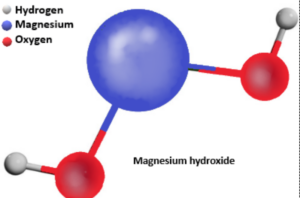Magnesium hydroxide Formula
The chemical formula of magnesium hydroxide is Mg(OH)2. It indicates that each magnesium ion (Mg2+) is surrounded by two hydroxide ions (OH-) in the compound.
Structure of Magnesium hydroxide
Magnesium hydroxide forms a crystal lattice structure. The magnesium cation (Mg2+) has a 2+ charge, and each hydroxide anion (OH–) has a 1- charge. In the crystal lattice, the magnesium ions are surrounded by six hydroxide ions, forming an octahedral coordination arrangement. This arrangement contributes to the stability of the crystal lattice.

Physical Properties of Magnesium hydroxide
- State: Magnesium hydroxide exists as a white solid at room temperature.
- Solubility: It is sparingly soluble in water, meaning only a small amount dissolves in water. The resulting solution is slightly alkaline.
- Density: The density of solid magnesium hydroxide is approximately 2.36 g/cm³.
- Melting Point: It has a relatively high melting point of around 350-450 degrees Celsius.
- Appearance: Magnesium hydroxide is a white powder with a crystalline structure.
Chemical Properties of Magnesium hydroxide
- Neutralization: Magnesium hydroxide is a weak base and can react with acids to form salts and water through a neutralization reaction. For example:
Mg(OH)2 + 2HCl → MgCl2 + 2H2O
- Amphoteric Nature: Magnesium hydroxide exhibits amphoteric properties, meaning it can act as both a base and an acid. It can react with both strong acids and strong bases, depending on the conditions.
- Thermal Decomposition: Upon heating, magnesium hydroxide decomposes to form magnesium oxide (MgO) and water vapor:
Mg(OH)2 → MgO + H2O
- Adsorption: Magnesium hydroxide has adsorption properties and can be used as an adsorbent in various applications, such as in wastewater treatment or as an antacid.
- Pharmaceutical Use: Magnesium hydroxide is commonly used as an antacid to neutralize excess stomach acid and alleviate symptoms of indigestion or heartburn.
- Flame Retardant: Due to its ability to release water when heated, magnesium hydroxide is used as a flame retardant in plastics and other materials.
- Precipitation Reactions: Magnesium hydroxide can precipitate from solutions containing magnesium ions (Mg2+) and hydroxide ions (OH–), especially when the pH is raised to alkaline conditions.
Solved examples on the Magnesium Hydroxide Formula:
Example 1: Calculate the mass of magnesium hydroxide (Mg(OH)2) required to neutralize 25 mL of 0.5 M hydrochloric acid (HCl).
Solution:
First, we need to determine the number of moles of hydrochloric acid used in the reaction.
Molarity (M) = Moles (n) / Volume (V)
0.5 M = n / 0.025 L (converting mL to L)
n = 0.5 * 0.025 = 0.0125 moles
Since the balanced chemical equation between hydrochloric acid and magnesium hydroxide is:
2HCl + Mg(OH)2 → MgCl2 + 2H2O
We can see that the stoichiometric ratio between HCl and Mg(OH)2 is 2:1.
Therefore, the number of moles of magnesium hydroxide required will be half of the moles of hydrochloric acid:
0.0125 moles / 2 = 0.00625 moles
Now, we can calculate the mass of magnesium hydroxide using its molar mass.
Molar mass of Mg(OH)2 = (1 * atomic mass of Mg) + (2 * atomic mass of O) + (2 * atomic mass of H)
= (1 * 24.31 g/mol) + (2 * 16.00 g/mol) + (2 * 1.01 g/mol)
= 24.31 g/mol + 32.00 g/mol + 2.02 g/mol
= 58.33 g/mol
Mass of Mg(OH)2 = moles * molar mass
= 0.00625 moles * 58.33 g/mol
= 0.364 g
Therefore, approximately 0.364 grams of magnesium hydroxide are required to neutralize 25 mL of 0.5 M hydrochloric acid.
Example 2: A 500 mL solution contains 10 grams of magnesium hydroxide (Mg(OH)2). Calculate the molarity of the magnesium hydroxide solution.
Solution:
To calculate the molarity, we need to determine the number of moles of magnesium hydroxide and the volume of the solution.
Moles (n) = Mass / Molar mass
= 10 g / (24.31 g/mol + 2 * 16.00 g/mol + 2 * 1.01 g/mol)
= 10 g / 58.33 g/mol
≈ 0.171 mol
Volume (V) = 500 mL = 500/1000 L = 0.5 L
Molarity (M) = Moles (n) / Volume (V)
= 0.171 mol / 0.5 L
= 0.342 M
Therefore, the molarity of the magnesium hydroxide solution is approximately 0.342 M.
Frequently asked questions on Magnesium Hydroxide Formula
1: What is magnesium hydroxide used for?
Answer: Magnesium hydroxide is used to soothe chronic constipation as a laxative. Magnesium hydroxide is also used as an antacid to treat indigestion, heartburn and acidic stomach.
2: Is Milk of Magnesia the same as magnesium?
Answer: Magnesia milk can reduce constipation and improve heartburn and indigestion. Magnesium milk is sometimes referred to as magnesium hydroxide which is its chemical name. Magnesia milk is available to purchase without a prescription over the counter.
3: Is magnesium hydroxide a precipitate?
Answer: Mg(OH)2 is given partial precipitation with NH4OH by the magnesium ion (Mg2+). Mg(OH)2 is very sparsely soluble in water but is readily soluble in solutions of ammonium salts. Zirconium hydroxide is precipitated by the solutions NH4OH and NaOH.
4: What is the pH value of magnesium hydroxide?
Answer: The base is magnesium hydroxide. It has approximately a pH of 10. Magnesium hydroxide is usually called magnesium milk.
5: Is magnesium hydroxide a weak base?
Answer: Unlike lime, it is also much more difficult to treat magnesium hydroxide than it is caustic (NaOH). At neutral pH levels and higher, magnesium hydroxide is nearly insoluble in water. Keeping this in mind, mag has little to no effect on water alkalinity above 7.0 pH.





